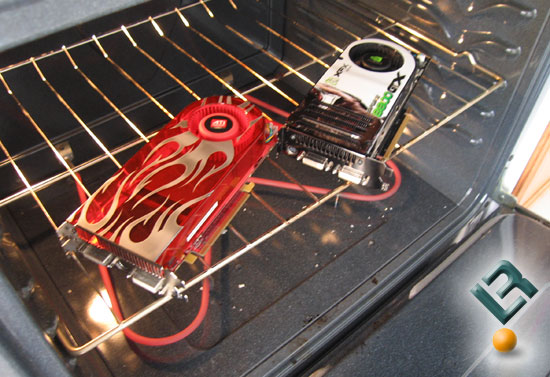Using ATI and NVIDIA Video Cards To Make A Sauna
Final Thoughts

Summary:
|
Video Card Tested |
Exhaust Temperature |
PCB Temperature |
|
BFG Tech GeForce 8800 GTS OC 640MB |
54.0 |
53.5 |
|
XFX GeForce 8800 GTX |
55.5 |
65.5 |
|
ATI Radeon HD 2900 XT |
48.5 |
63.5 |
Keep in mind the temperature of the piece of paper with the system turned off was 23.5C! The GeForce 8800 GTX had the highest measured temperatures of the three. The numbers shown above where the highest observed during testing. It should be noted that both GeForce 8800 cards had a constant exhaust temperature of their recorded value +/- 1C, while the Radeon HD 2900 HD only hit 48.5 when the fan ws running on high for a brief second. Once the fan on the Radeon HD 2900 slowed down the exhaust air temperature decreased by 3-4C. One final observation was the amount of air that both fans were able to push. The ATI card seems to have a higher CFM fan on it, but then again the GeForce 8800 GTX has more area for the air to come out. One final difference between the cards that were tested is where the hot air goes. With the ATI Radeon HD 2900 XT all the hot air is blown out of the case, while on the GeForce 8800 series the majority of it is blown right back in the case with a little bit making it outside. It would be interesting to see how the GeForce 8800 series would perform with a stronger fan and a fan housing design that took all the air outside of the case.
Final Thoughts:
Both the GeForce 8800 series and Radeon HD 2900 series were found to have an exhaust air temperature of 49C-56C, which is enough to heat up a small office, bedroom or dorm room very quickly. It’s interesting to see just how hot these cards are getting and with both ATI and NVIDIA promoting multiple GPU solutions just imagine running a pair of any of these cards is a small room for an extended period of time. It’s obvious that the GPU is now the leading cause of heat in a computer system, but what can be done about it? With the PCB on these video cards hitting 65C and the exhaust temperature not too far behind, it’s starting to become a little too much if you ask me.
What can be done to reduce the heat output on video cards? The most obvious is to reduce the amount of leakage on the GPU core. That takes time and money though and the video card industry usually has a new core out every six months. Shrinking the die should help, but it seems even with die shrinks video cards keep getting hotter. The only other option that would be worth considering would be something like Intel’s SpeedStep or AMD’s Cool’n’Quiet that would reduce the frequency and voltage of the GPU when it’s not under a heavy load. Most video cards have a 2D clock setting and a 3D clock setting that reduces the clock and memory frequency, but it seems that now is a good time to expand on those technologies to help keep things nice and cool.
Now, I have the tough choice as to what video card to use in my system as when I’m not gaming I don’t want to be penalized with high temperatures for having a gaming card installed in my office pc. If you’ve noticed higher room temperatures after moving to a higher end graphics cards, please shoot me an e-mail or put a comment in the forums. I’d love to hear if others are having the same issue! For now I’m lowering the air conditioner and am going to fire back up S.T.A.L.K.E.R. because I’m officially off work and I’m trying to lose weight!
Legit Bottom Line: High end gaming graphics cards from both AMD and NVIDIA are increasing global warming!

P.S. No video cards were injured by the turned on oven or the flames from the BBQ grill. Please note the video cards that were used are trained professionals with years of experience.

Comments are closed.